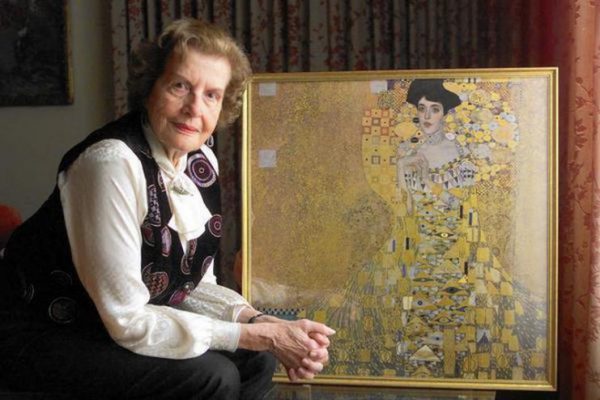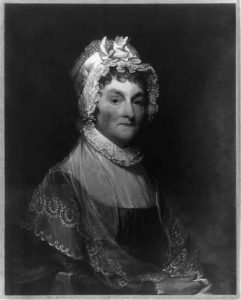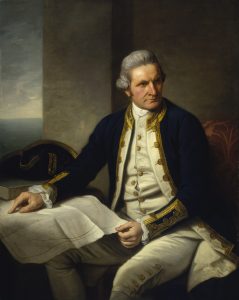Maria Altmann was alone in her home in Los Angeles, California, sitting there and thinking. She was thinking about all the heartache she had gone through in the span of her life so far, and thinking about those brutal years that she had had to live through in Vienna. She was thinking about her family and all of the possessions that had been taken from her by the Nazi’s, that she knew she was to never going see again, and especially she was thinking about the beautiful portrait of her aunt, Adele Bloch-Bauer, that embodied her aunt in a way that her memory never could. Not wanting to just think about all this, she decided to take action, and in 1998 she called Randol Schoenberg to begin the process of getting back the Portrait of Adele Bloch-Bauer I.
Maria Altmann and her husband fled Vienna in 1938, leaving her parents behind to go to the U.S. She had decided to start over and make a life of her own. Her husband and she were victims of an escalating antisemitism in the now German-held Austria, which was why they fled to America. They had subsequently lived well for fifty-six years until her husband had passed away due to a stroke and then a fall in 1994, leaving her solitary and to her thoughts, which kept on going back to the family that she had to leave behind in Vienna.1 Feeling alone and sad, she began to think back to the harsh years that she had lived in Vienna with her family, and she began to feel a need to reconnect somehow with that family that was no longer around. When she got a call in February of 1998 from an old friend in Vienna, informing her about an article that had appeared in the newspaper about the Bloch-Bauer Klimt collection, and it made her mad, because the Austrians had taken everything away from her.2 A few weeks had passed, she had done a lot of contemplating about the new information that she had learned, but her thoughts remained on the paintings, and on her dear aunt Adele Bloch-Bauer, and she started to think about the one particular painting of her.

There had been a total of six paintings that were looted from her uncle’s house by the Nazis in the 1930s, and Maria had decided that she wanted them all back, especially the Portrait of Adele Bloch-Bauer I.3 The Portrait of Adele Bloch-Bauer I was painted in 1907 by Gustav Klimt and had originally belonged to the Bloch-Bauer’s before it was looted by the Nazi’s, and then taken into the Austrian government’s possession. When she contacted Randol in September of 1998, he was unsure about taking on the case. He had a lot of Austrian roots that ran deep, but he felt as though he had no real connection to this at all. After talking with Maria about the subject for a while, he decided to do a little bit of research, which led him to the Restitution Law, which then led him to agree to take up the case, and so he brought it up to his boss. His boss agreed and thought that this would be a compelling case, but that he wasn’t quite sure that it was worth the firm’s time and referred to it as a long-shot case. But Randol was now determined, and if he had to, he would pursue the Altmann case on his own, which started the odd pairing of Randol and Maria versus Austria.4
In 1999, the suit was filed against the Republic of Austria in an Austrian court. This was the beginning of her efforts to get the paintings back, but she then dismissed the case because she didn’t have enough funds to pay the attorney fees. So, in being unable to bring suit in Austria, she then decided to try her luck and refile her suit in the U.S. District Court for the Central District of California. Her claim was that the confiscation of property was in violation of international law, which was better known as the Foreign Sovereign Immunities Act (FSIA), and brought that against not only Austria but the Austrian Gallery as well. Mr. Shoenberg and Ms. Altmann took a huge risk in submitting their case to binding arbitration in Austria.5 Once their case had been submitted and approved, they kept on thinking about what their next step would be and how to go about it, due to the fact that this was a very delicate case that they needed to treat with care. As they continued to think of their next steps, Mr. Shoenberg began to communicate by email with an investigative reporter from Austria named Hubertus Cerzin. As the emails progressed, Mr. Shoenberg learned that Mr. Cerzin was on the same side as him and Ms. Altmann, and also grew as impatient as them due to the fact that he was seriously ill. They talked about requesting the wording of Adele’s will, but that it had to be done in such a way that it would not seem as if they were demanding it. As their correspondence continued, he informed Randol on December 19, 1998, that he had asked Frodl to fax him Adele’s last will, but that he did not want to, due to the fact that Frodl believed that if he did, the will would be sent around the world.6 With the continuous back and forth of them trying to get Adele’s will, and Frodl and people like him saying that they couldn’t give it to them, Hubertus got fed up with it all. So he reached out to moles that he had in the Vienna archives, because they needed the will; it was the key to the whole case. After more time, and waiting on Hubertus’s part for his mole to get his hands on the will, he finally sent word back to Mr. Shoenberg in January 1999. Fax had begun to scroll into Mr. Shoenberg’s office, and it was Adele’s will.7

While Shoenberg and Hubertus were dealing with getting Adele’s will, Maria Altmann had been going through a separate series of events as well as the same ones that Shoenberg had been going through. This was all a lot more personal for her. It was her history and she was trying to right it. She had to go to Austria, after not having being there since 1938. It was hard for her, seeing how some things from her childhood had changed, but others remained. In March of 1999, her spirits began to soar, and her resolve was growing stronger, due to the fact that she had been invited to speak at a restitution conference. She was a woman on a mission, and she was determined in setting out to settle a score with history.8 She had taken a taxi, and along the way, she asked the driver to stop at Karl-Lueger-Platz, as well as the front door of the place she once called home, Strubenbastei, and at both places, she was filled with nostalgia as well as sadness, because it wasn’t exactly how she remembered it. It had changed as time had passed, and although she recognized the places, they weren’t the same. While still standing on the path in front of her old home, and being filled with all of these emotions, she realized that the Austrians had stolen her family’s life, and in return had not offered any contribution. She then went on to hail a cab to take her to the Belvedere, where she went on to seek out the gorgeous painting of her aunt. As she stared at it, she was filled with many memories that she had with her aunt, and felt at peace as she continued to stare. As a few minutes passed, she asked someone to take a picture of her in front of the painting, and as the flash went off, a guard came over to tell them that pictures were prohibited, which angered Maria because that painting was of her aunt and belonged to her family.9
As events continued to progress, they began to escalate quicker, starting with the Austrian panel recommending against the return of the Klimt paintings in June, saying that only sixteen of the Klimt drawings of Adele and pieces of Ferdinand’s porcelain should be returned. Although this decision was not unanimous due to one of the panelists protesting against the decision, it still infuriated Maria and Mr. Shoenberg. Maria wrote that the Belvedere “is not the legal owner of these paintings,” and that they were “keenly aware of the Gold Portrait’s importance as a national treasure. Once the Beirat decides to recognize our legal right to the paintings, we would then be in a position to work out a way with you that leaves the portrait in Vienna.” Even though Maria was very reasonable with what she was asking, she never received a response to her letter. This infuriated Shoenberg even further, as he went on to exclaim that “the world now knows that the Klimt paintings are Nazi-looted art. No amount of whitewashing, or legalistic argumentation can erase that fact.” He even went as far as trashing a fragile china shop that was in Vienna.10
As the months passed and then turned into years, Altmann and Shoenberg continued their dance with the Austrian court. They became more stressed, due not only to the case but to personal issues as well. Shoenberg had a young daughter, Dora, and a son on the way, which had him stressed, as well as having Crohn’s disease, which made him hard to insure. So in April of 2000, he ended up quitting his job.11 Maria, on the other hand, began to wonder whether she would ever be able to see the end of this long and tiring case that she had begun.

Even though Maria was losing hope in her search for justice, and was becoming tired of all the continuous arguing back and forth with the U.S. District Court for Central District of California, she argued that her case was valid due to the fact that the “Austrian Gallery’s present day publishing and advertising activities of the Klimt paintings in the United States satisfied the commercial activity condition.” And even though she made a very valid point with that argument, Austria continued arguing that they were immune from the jurisdiction of the U.S. federal and stated courts under the FSIA, because the allegations had occurred before the FSIA was enacted. The FSIA is a United States law that establishes the limitations on a foreign sovereign nation (or its political subdivisions, agencies, or instrumentalities) on whether it can be sued in United States courts, at the federal or state levels. After waiting for a response from the U.S. Supreme Court, and losing hope that it would go her way, in 2004 the vote was held. By a six to three vote, it had been ruled that the FSIA did, in fact, apply to pre-1952 conduct, and so she had the right to pursue her claim.12 This was decided because, “As a result, the Court changed the face of the FSIA and reversed years of precedent to the contrary. The Court in Altmann decided that the Austrian government could not expect immunity in light of its complicity in and perpetuation of the expropriation of the Klimt paintings.”13
As the case continued to progress, the Austrian government continued to throw curveballs at the case whenever they could, but that did not deter Maria nor Shoenberg from the goal they had set. The case had been gaining a lot more attention than anyone had anticipated, which was making Austria grow concerned. And with it being decided that Maria and other heirs would be receiving a $21.8 billion award from a Swiss restitution fund in April of 2005, it made it clear that the tides were turning, and quickly. The Austrians even went as far as giving Maria the offer to submit the case to binding arbitration with a panel of Austrian legal experts, which Mr. Shoenberg thought they should take, if she would want the case to be decided in her lifetime. Maria had called him crazy, but after talking it through with him, she had agreed.14

Once Shoenberg had made his points for the return of the paintings, and the Austrian lawyers made their points against it. Three arbitrators gathered to make the final decision on January 15, 2006. The room became tenser, as the final decision was about to be made, and Maria couldn’t help but feel nervous, because the ruling would determine whether she had wasted all of these years of her life, or not. As the three arbitrators had called everyone back in to say the final hearing, the Austrians were sure that they had won, while Maria was deflated in her seat being sure that she had lost. But with a turn of events, Mr. Shoenberg had won the case!15 Maria was overjoyed in learning that she had not, in fact, wasted years of her life. She was then later on asked about the future of the paintings; she replied that they belonged on public display because she wouldn’t want a private buyer to get them, due to the fact that they are meaningful to her and that she wanted to share them with everyone else.16
Once the paintings were back in her possession, she decided to then sell the Portrait of Adele Bloch-Bauer I on behalf of her family to the Neue Galerie in New York City, and since then it has been on display there.17 The perseverance that she had shown throughout the whole ordeal helped to inspire many other people, including countries as well, to get back what was rightfully theirs, no matter how long it took.
- Anne-Marie O’Conner, The Lady in Gold: The Extraordinary Tale of Gustav Klimt’s Masterpiece, Portrait of Adele Bloch-Bauer (New York: Knopf, 2012), 225. ↵
- Anne-Marie O’Conner, The Lady in Gold: The Extraordinary Tale of Gustav Klimt’s Masterpiece, Portrait of Adele Bloch-Bauer (New York: Knopf, 2012), 226. ↵
- Sue Choi, “The Legal Landscape of the International Art Market After Republic of Austria v. Altmann,” Northwestern Journal of International Law & Business 26, no. 1 (Fall 2005): 171. ↵
- Anne-Marie O’Conner, The Lady in Gold: The Extraordinary Tale of Gustav Klimt’s Masterpiece, Portrait of Adele Bloch-Bauer (New York: Knopf, 2012), 228. ↵
- William Grimes, “Maria V. Altmann Pursuer of Family Klimts, Dies at 94.” The New York Times, February 9, 2011. ↵
- Anne-Marie O’Conner, The Lady in Gold: The Extraordinary Tale of Gustav Klimt’s Masterpiece, Portrait of Adele Bloch-Bauer (New York: Knopf, 2012), 231. ↵
- Anne-Marie O’Conner, The Lady in Gold: The Extraordinary Tale of Gustav Klimt’s Masterpiece, Portrait of Adele Bloch-Bauer (New York: Knopf, 2012), 231. ↵
- Anne-Marie O’Conner, The Lady in Gold: The Extraordinary Tale of Gustav Klimt’s Masterpiece, Portrait of Adele Bloch-Bauer (New York: Knopf, 2012), 232. ↵
- Anne-Marie O’Conner, The Lady in Gold: The Extraordinary Tale of Gustav Klimt’s Masterpiece, Portrait of Adele Bloch-Bauer (New York: Knopf, 2012), 232. ↵
- Anne-Marie O’Conner, The Lady in Gold: The Extraordinary Tale of Gustav Klimt’s Masterpiece, Portrait of Adele Bloch-Bauer (New York: Knopf, 2012), 233. ↵
- Anne-Marie O’Conner, The Lady in Gold: The Extraordinary Tale of Gustav Klimt’s Masterpiece, Portrait of Adele Bloch-Bauer (New York: Knopf, 2012), 235. ↵
- William Grimes, “Maria V. Altmann Pursuer of Family Klimts, Dies at 94,” The New York Times, February 9, 2011. ↵
- Sue Choi, “The Legal Landscape of the International Art Market After Republic of Austria v. Altmann,” Northwestern Journal of International Law & Business 26, no. 1 (Fall 2005): 175. ↵
- Anne-Marie O’Conner, The Lady in Gold: The Extraordinary Tale of Gustav Klimt’s Masterpiece, Portrait of Adele Bloch-Bauer (New York: Knopf, 2012), 250. ↵
- Anne-Marie O’Conner, The Lady in Gold: The Extraordinary Tale of Gustav Klimt’s Masterpiece, Portrait of Adele Bloch-Bauer (New York: Knopf, 2012), 252. ↵
- Anne-Marie O’Conner, The Lady in Gold: The Extraordinary Tale of Gustav Klimt’s Masterpiece, Portrait of Adele Bloch-Bauer (New York: Knopf, 2012), 253. ↵
- William Grimes, “Maria V. Altmann Pursuer of Family Klimts, Dies at 94.” The New York Times, February 9, 2011. ↵




41 comments
Estefanie Santiago Roman
I had never heard of this case or this painting before, although I do recognize the art style because of the famous painting of “The Kiss” also by Gustav Klimt. It is quite known about similar cases where governments take artwork that do not belong to them, and usually it is artwork from a different country. It is satisfying to know that Maria Altmann was able to win this case despite all the years of struggle, and that she was kind enough to share her most important “treasure” with the public.
Stephen Talik
I had never heard of this story before, but I loved Maria’s determination and her fight to recover what her family had lost. I doubt many people would have been willing to fight in court and jump through hoops for decades for what was, by all accounts, a lost cause, yet she succeeded in the end. This case was also important precedent for other similar recovery and restoration efforts, and because of that the lives she touched by her actions stretched far more than just her and her family.
Zachary Kobs
However sad this story may be, the case of commitment to getting back what was rightfully hers truly inspired me. Thank goodness for the laws that are in place that protect our rights like the Foreign Sovereign Immunities Act (FSIA). Never having heard about this case prior I felt as though I lived through it with Maria due to the excellent storytelling by the author.
Kacey Diaz
I loved this article and the fighting spirit of Maria. What I was able to take away from this story was perseverance and familial roots. Maria didn’t have to fight as hard for this case as she did, this case took a long time for her to win and she was hit with one obstacle after another. This story was really inspiring and well written and researched.
Margaret Cavazos
The journey in this article was deeply personal to Maria Altmann. She had fled her home decades before, and had lost much of her family and possessions. After losing her husband, it is clear that her tragic early life came back to haunt her. It is unfortunate that the Austrian government would not take a more understanding view of Mrs. Altmann’s attempt to get her to get her family’s stolen property back in the possession of her family. It’s encouraging that her lawyer as well as others she appealed to were willing to go that distance to help her regain these stolen family treasures. I find it very humble of Mrs. Altmann to place many of the pieces of art in museums (once she was granted ownership) where they would be kept safe and shared with others to educate the public about art stolen by the Nazi’s. All Mrs. Altmann wanted was these works of art to be restored to her family’s ownership. It is fortunate that this story gained the attention of the media, which may have helped her case, because even though the art was stolen by the Nazi’s during a time of horrific anti-semitism, she still had to struggle to regain ownership of works of art stolen from her family.
Francisco Cruzado
This story certainly conveys an air of defiance and commitment, and it reminds me how important is memory for many people, how the past can play such a role into our need for an identity. Ms. Altmann needed an answer whenever she remembered, and I guess she longed for a material but also symbolic memory as it was the painting. The description of the court cases were excellent. I felt myself immersed in some scenes that were described. Very well written!
Andrea Degollado
This is a deeply saddening story. However Maria Altmann used all the heartaches that she had gone through and decided to use that as motivation, which in my opinion is very admirable. I think it’s also very admirable that Maria was willing and able to continue with this case for years, when someone else would have probably given up especially with the other issues she and her husband were facing in their personal life. As someone that has never really heard of this story, this article does a good job in informing you about Maria Altmann’s story.
Amanda Shoemaker
I vaguely remember hearing about this right after Maria had won her case. I remember thinking that it was inspirational to anyone that had ever had something taken from them. This article . does a great job describing all of the hardships she went through to obtain what was rightfully hers. I wasn’t aware of how many years that it took and how hard the Austrian government tried to keep it from her. Very inspirational article.
Destiny Lucero
Maria Altmann took on a case that took almost ten years to finalize and it was one of the most important choices of her lifetime. Her first choice was that she and her husband fled from her home Vienna, to the U.S in 1938. After a life well lived and all that happened-her possessions, family, and friends being taken from the Nazis and having to start over, her husband passed away leaving her alone. She couldn’t help being taken back by memory lane. She decided she would take back what is hers and she wouldn’t take no for an answer. She took on the case Randol and Maria vs. Austria to get back the gold beautiful painting of her aunt that was near and dear to her heart- The Portrait of Adele Bloch-Bauer I. From 1998 to 2006, the case was a long shot and went through many ups and downs, also many people were involved. All though Maria had all the facts in line to build a great case, Austria took every shot they had to deter it. In 2000, Shoenburg grew ill and had to quit, and near the end of the case, Maria was worried she wasted all the years fighting for nothing. She was the underdog and sure she would lose; however, it was finalized that she won! She was a fighter. The painting is now in New York City, at the Neue Galerie. What an amazing story!
Jacy Hornsby
This is a deeply moving story. In a way she wasn’t just getting her belongings back, she was getting a small form of justice for her family and herself. I personally love works by Klimt so learning about this story just makes me appreciate the work even more. I Klimt is famous for his golden pieces, but I think it is interesting to think about how her family members were portrayed in gold but in reality they were in the midst of the Nazi occupation and trying to survive another day. It’s like a weird contrast that simple fate created on its own. In a way that too is art.